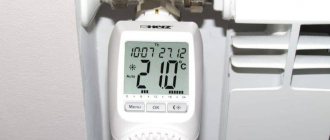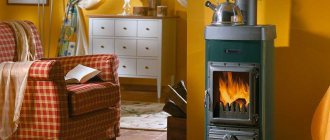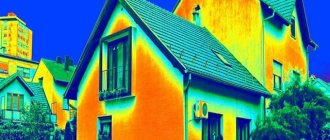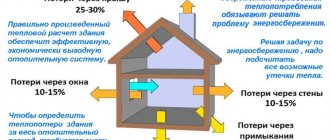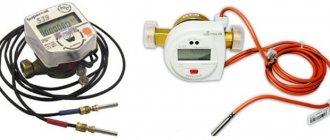What is it - specific heat consumption for heating? In what quantities is the specific consumption of thermal energy for heating a building measured and, most importantly, where do its values come from for calculations? In this article we are going to get acquainted with one of the basic concepts of heating engineering, and at the same time study several related concepts. So, let's go.
Be careful, comrade! You are entering the jungle of heating engineering.
What it is
Definition
The definition of specific heat consumption is given in SP 23-101-2000. According to the document, this is the name for the amount of heat required to maintain a normal temperature in a building, related to a unit of area or volume and to another parameter - the degree-day of the heating period.
What is this parameter used for? First of all, to assess the energy efficiency of a building (or, what is the same, the quality of its insulation) and plan heat costs.
Actually, SNiP 02/23/2003 directly states: the specific (per square or cubic meter) consumption of thermal energy for heating a building should not exceed the given values. The better the thermal insulation, the less energy heating requires.
Degree-day
At least one of the terms used needs clarification. What is a degree day?
This concept directly refers to the amount of heat required to maintain a comfortable climate inside a heated room in winter. It is calculated using the formula GSOP=Dt*Z, where:
- GSOP – desired value;
- Dt is the difference between the normalized internal temperature of the building (according to current SNiP it should be from +18 to +22 C) and the average temperature of the coldest five days of winter.
- Z – length of the heating season (in days).
As you might guess, the value of the parameter is determined by the climatic zone and for the territory of Russia varies from 2000 (Crimea, Krasnodar Territory) to 12000 (Chukchi Autonomous Okrug, Yakutia).
Winter in Yakutia.
Units
In what quantities is the parameter of interest to us measured?
- SNiP 02/23/2003 uses kJ/(m2*S*day) and, in parallel with the first value, kJ/(m3*S*day).
- Along with the kilojoule, other units of heat measurement can be used - kilocalories (Kcal), gigacalories (Gcal) and kilowatt-hours (KWh).
How are they related?
- 1 gigacalorie = 1,000,000 kilocalories.
- 1 gigacalorie = 4,184,000 kilojoules.
- 1 gigacalorie = 1162.2222 kilowatt-hours.
The photo shows a heat meter. Heat metering devices can use any of the listed units of measurement.
Factors affecting thermal load
- Wall material and thickness. For example, a 25-centimeter brick wall and a 15-centimeter aerated concrete wall can transmit different amounts of heat.
- Roof material and structure. For example, the heat loss of a flat roof made of reinforced concrete slabs is significantly different from the heat loss of an insulated attic.
- Ventilation. The loss of thermal energy with exhaust air depends on the performance of the ventilation system and the presence or absence of a heat recovery system.
- Glazing area. Windows lose more thermal energy compared to solid walls.
- Insolation levels in different regions. It is determined by the degree of absorption of solar heat by external coverings and the orientation of the planes of buildings in relation to the cardinal points.
- Temperature difference between the street and the room. It is determined by the heat flow through the enclosing structures under the condition of constant resistance to heat transfer.
Normalized parameters
They are contained in the appendices to SNiP 02/23/2003, tab. 8 and 9. Here are excerpts from the tables.
For single-family, one-story detached houses
| Heated area | Specific heat consumption, kJ/(m2*S*day) |
| Up to 60 | 140 |
| 100 | 125 |
| 150 | 110 |
| 250 | 100 |
For apartment buildings, dormitories and hotels
| Number of storeys | Specific heat consumption, kJ/(m2*S*day) |
| 1 – 3 | According to the table for single-family houses |
| 4 – 5 | 85 |
| 6 – 7 | 80 |
| 8 – 9 | 76 |
| 10 – 11 | 72 |
| 12 and above | 70 |
Please note: as the number of floors increases, the heat consumption rate decreases. The reason is simple and obvious: the larger an object of a simple geometric shape, the greater the ratio of its volume to surface area. For the same reason, the specific heating costs of a country house decrease with an increase in the heated area.
Heating a unit of area in a large house is cheaper than heating a small one.
Computations
It is almost impossible to calculate the exact value of heat loss for an arbitrary building. However, methods for approximate calculations have long been developed that give fairly accurate average results within the limits of statistics. These calculation schemes are often referred to as calculations based on aggregated indicators (meters).
Along with thermal power, there is often a need to calculate daily, hourly, annual thermal energy consumption or average power consumption. How to do it? Let's give a few examples.
Hourly heat consumption for heating using enlarged meters is calculated using the formula Qot=q*a*k*(tin-tno)*V, where:
- Qot – the desired value in kilocalories.
- q – specific heating value of the house in kcal/(m3*S*hour). It is looked up in directories for each type of building.
The specific heating characteristic is tied to the size, age and type of building.
- a is the ventilation correction factor (usually 1.05 - 1.1).
- k – correction factor for climatic zone (0.8 – 2.0 for different climatic zones).
- tin – internal temperature in the room (+18 – +22 C).
- tno – street temperature.
- V – volume of the building together with enclosing structures.
To calculate the approximate annual heat consumption for heating in a building with a specific consumption of 125 kJ/(m2*S*day) and an area of 100 m2, located in a climate zone with the GSOP=6000 parameter, you just need to multiply 125 by 100 (house area ) and by 6000 (degree days of the heating period). 125 * 100 * 6000 = 75,000,000 kJ, or approximately 18 gigacalories, or 20,800 kilowatt-hours.
To convert the annual consumption into the average thermal power of heating equipment, it is enough to divide it by the length of the heating season in hours. If it lasts 200 days, the average heating power in the above case will be 20800/200/24=4.33 kW.
Heat load distribution
For water heating, the maximum thermal power of the boiler should be equal to the sum of the thermal power of all heating devices in the house. The distribution of heating devices is influenced by the following factors:
- Room area and ceiling height;
- Location inside the house. Corner and end rooms lose more heat than rooms located in the middle of the building;
- Distance from the heat source;
- Desired temperature in the rooms.
SNiP recommends the following values:
- Living rooms in the middle of the house - 20 degrees;
- Corner and end living rooms - 22 degrees. At the same time, due to the higher temperature, the walls do not freeze;
- Kitchen - 18 degrees, since it has its own heat sources - gas or electric stoves, etc.
- Bathroom - 25 degrees.
With air heating, the heat flow that enters a separate room depends on the throughput of the air hose. Often the simplest way to adjust it is to adjust the position of the ventilation grilles with temperature control manually.
In a heating system that uses a distribution heat source (convectors, heated floors, electric heaters, etc.), the required temperature mode is set on the thermostat.
Energy
How to calculate energy costs with your own hands, knowing the heat consumption?
It is enough to know the calorific value of the corresponding fuel.
The easiest way is to calculate the energy consumption for heating a house: it is exactly equal to the amount of heat produced by direct heating.
An electric boiler converts all consumed electricity into heat.
Thus, the average power of an electric heating boiler in the last case we considered will be equal to 4.33 kilowatts. If the price of a kilowatt-hour of heat is 3.6 rubles, then we will spend 4.33*3.6=15.6 rubles per hour, 15*6*24=374 rubles per day, and so on.
It is useful for owners of solid fuel boilers to know that firewood consumption rates for heating are about 0.4 kg/kWh. Coal consumption rates for heating are half as much – 0.2 kg/kW*h.
Coal has a fairly high calorific value.
Thus, in order to calculate the average hourly consumption of firewood with your own hands at an average heating power of 4.33 kW, it is enough to multiply 4.33 by 0.4: 4.33 * 0.4 = 1.732 kg. The same instructions apply to other coolants - just look in the reference books.
Heat load calculation
The need to comply with all safety and reliability standards is extremely important when designing facilities, but calculating the thermal load of the building is no less important.
Why do you need to calculate the thermal load when designing a building?
This operation will allow you to find out how much fuel the heating system needs to operate, correctly determine the heat source and calculate heat loss throughout the entire system. It’s worth noting right away that calculating the heat load for heating allows you to find out how much heat all heating devices provide. All this information allows you to save large sums in comparison with heating systems that were not calculated correctly.
First of all, it is worth deciding which heating objects should be calculated. Such objects include:
- General heating system;
- Underfloor heating (if available);
- Ventilation devices;
- Water heating system;
- Other objects that require connection to the heating system, for example, swimming pools.
In addition, the calculation of the heat load can be affected by the smallest objects and objects where heat loss is possible.
Calculation procedure
It should be noted that all calculations made must be performed in accordance with GOST and building codes. For all systems there is a general list of parameters that must be calculated. These parameters are:
- Heat loss on external fences. This parameter allows you to select the optimal temperature for each room;
- The amount of power that will go to the hot water supply system;
- If you need to install an additional ventilation system, then calculating the heat required to heat the air circulating in it is also required;
- If there is a pool or bathhouse, the amount of heat required to heat these objects is calculated;
- If it is planned to expand the heating system in the future, then a calculation of the thermal load of the building must also be carried out.
It is also extremely important to know how heat flows are distributed throughout the room for each heating object
The importance of this knowledge lies in the fact that it allows you to most accurately select the elements necessary for the heating system
Key points for each type of heat load
Builders share several types of loads. Each type has its own characteristics that need to be analyzed.
First of all, seasonal load is distinguished. Its peculiarity is that throughout the year, temperature conditions outside the premises change, and heat costs are calculated depending on the climatic conditions of the place where the building is located.
In second place is the calculation of the heat load for heating throughout the year. Since most domestic buildings are characterized by this particular load, changes throughout the year are not critical, but in the summer the load becomes less by about 30 percent.
There are two more parameters that must also be taken into account in the calculation - latent and dry heat. The first parameter characterizes heat loss due to condensation and other evaporation. Calculation for dry heat is carried out taking into account the number of windows, doors, parameters of the ventilation system and possible losses in the cracks of the walls.
Advantages of turning to professionals when calculating thermal loads
Of course, it is possible to calculate the thermal load yourself, but this is a big risk, since there is a high probability of making a mistake. Many different parameters, the need to take into account losses at all possible heating objects and the overall complexity of all calculations can scare off an inexperienced person. It is in such cases that the help of an experienced specialist is necessary. Our company is able to make the most accurate calculations and select the most optimal equipment in the shortest possible time, while the cost and quality will pleasantly please you.
Contact us for advice by calling the numbers listed on the website or online.
